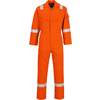
Orange
£46.01
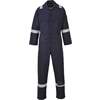
Navy
£42.78
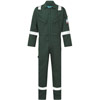
Green
£46.01
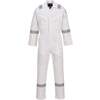
White
£46.01
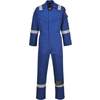
Royal Blue
£46.01
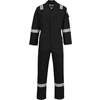
Black
£46.01
Show All Models
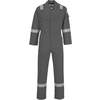
Grey
£46.01
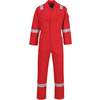
Red
£46.01

Red Tall
£54.85
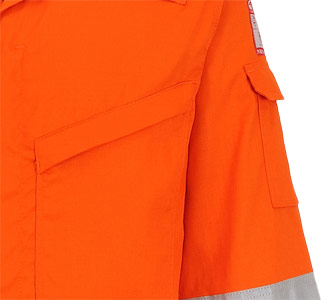
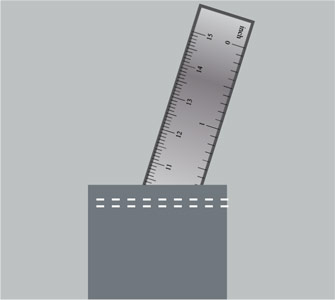
In order to comply with EN ISO 11611 all external pockets must be flapped, except for side pockets below the waist which do not extend more than ten degrees forward of the seam.
A single rule pocket with an opening not greater than 75mm is permitted behind the side seam on one or both legs.
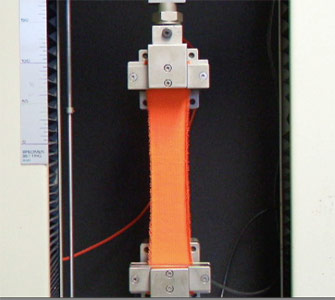
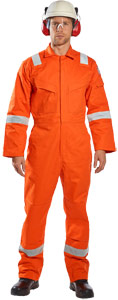
To meet EN ISO 11611 tensile strength must be at least 400N and tear strength must be at least 15N for class 1 and 20N for class 2.
For example:
Portwest's winning FR50 style has a tensile strength value of at least 500N and tear strength of at least 25N after 50 washes.
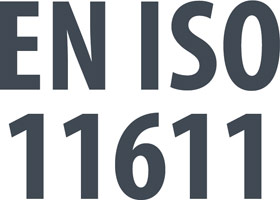
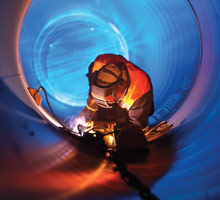
This international standard specifies minimum basic safety requirements and test methods for protective clothing for use in welding and allied processes (excluding hand protection). There are two classes with specific performance requirements.
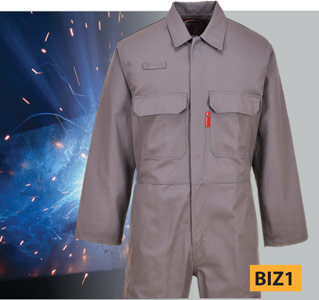
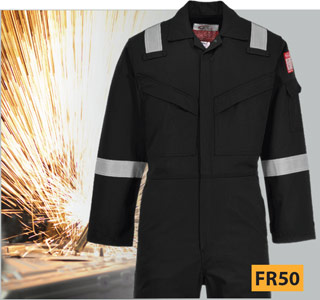
Class 1 is protection against less hazardous welding techniques and situations, causing lower levels of spatter and radiant heat.
Class 2 is protection against more hazardous welding techniques and situations, causing higher levels of spatter and radiant heat.
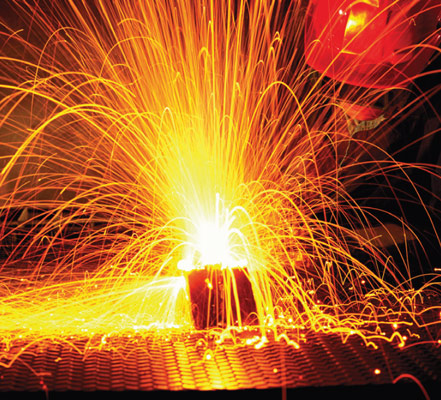
The EN ISO 11611: standard has the following parameters:
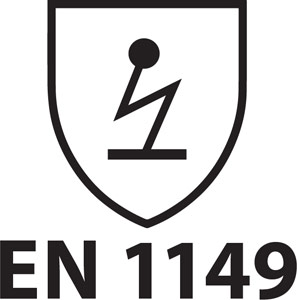
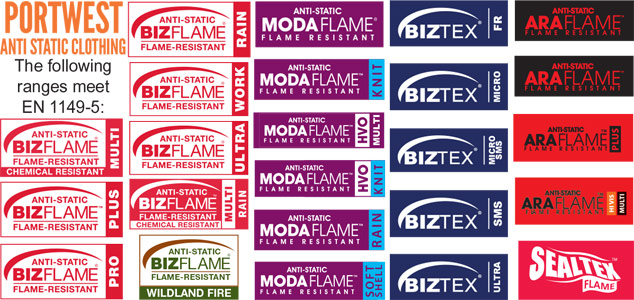
This European standard is part of a series of standards for test methods and requirements for electrostatic properties of protective clothing.
The standard specifies material and design requirements for garments used as part of a total earthed system, to avoid incendiary discharges.
The requirements may not be sufficient in oxygen enriched flammable atmospheres.
This European Standard is not applicable for specifying protection against main voltages.
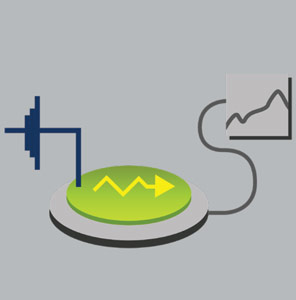
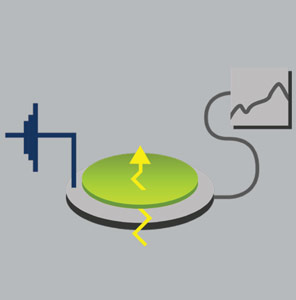
Test method for measurement of surface resistivity. Surface resistance measures the conductivity between two points on the surface of a fabric. The lower the resistance the higher the conductivity, resulting in charge going to earth.
Test method for measurement of the electrical resistance through a material (vertical resistance). This is the level of conductivity when measured through the depth of a fabric.

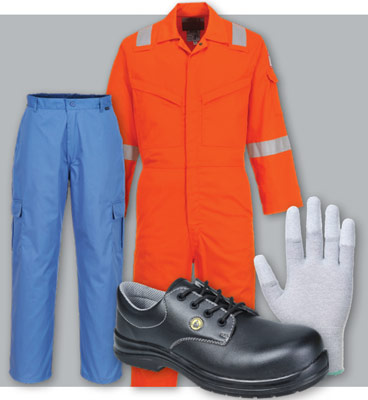
Test methods for measurement of charge decay. Charge decay measures how long it takes for an electric current to dissipate. The quicker it dissipates the higher the anti-static properties of the garment.
Please note the EN 1149-4 Garment Test is under development.
EN 1149-5 specifies the performance and design requirements to avoid static discharge for all electrostatic dissipative protective clothing as part of an entire earthed system, shoes, clothing & floor. The material meets the requirements.
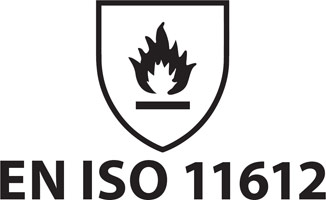
EN ISO 11612 is the standard for protective clothing which protects against heat and flame. Users for these garments include those who work in oil & gas, welding & allied processes, mining, petroleum and many other industries.
There are a host of specific tests conducted as part of EN ISO 11612, including tests for: Flame Spread, Tensile Strength, Tear Resistance, and Heat Resistance.

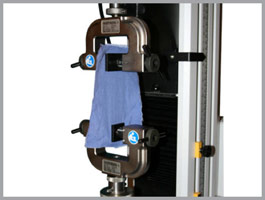
Flame Spread Test:
A flame is held against the fabric for ten seconds. After it is removed the fabric should not continue to burn. There should be no hole formation, melting or molten debris.
Tensile Strength Test:
The fabric must be able to withstand a minimum force of 300 newtons while being stretched or grabbed.

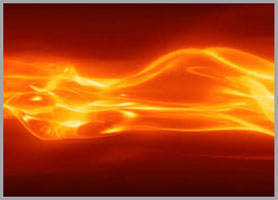
Tear Resistance Test:
The fabric must be able to withstand a minimum force of 10 newtons before it will tear.
Heat Resistance Test:
The fabric is placed in an oven at 180oC and must not ignite melt or shrink within the first 5 minutes in order to comply with the standard.
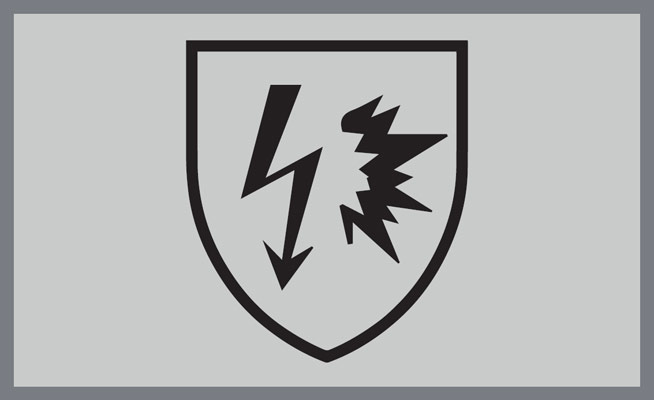
This standard investigates the fabric and garment's ability to protect against the thermal effects of an electric arc. This can be done via two test methods: 1. IEC 61482-1-1 (Open Arc Test Method) and 2. IEC 61482-1-2 (Box Test Method).
An electric arc is an intense flash of electricity which can result in numerous injuries.
Garments can be layered to achieve a better Cal rating. For example, a thermal layer may achieve an Ebt of 4.3 Cal/cm2, and an outer coverall may achieve an ATPV of 13.6 Cal/cm2. However, the combination ATPV/Ebt ratings will be greater than the sum of the two single layers, as the air gap between the two layers affords the wearer additional protection.
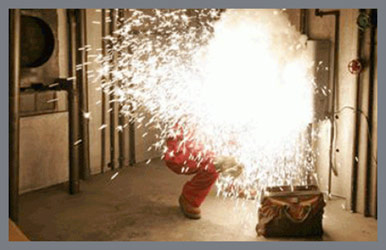
This test method aims to establish an ELIM (Incident Energy Limit) and an ATPV rating of a fabric and/or garment. These values, expresses as cal/cm², are the highest incident thermal energy to which the garment can be exposed without the wearer getting a second degree burn or the formation of holes in the fabric. The higher the cal rating of the garment or fabric, then the greater the protection for the wearer.
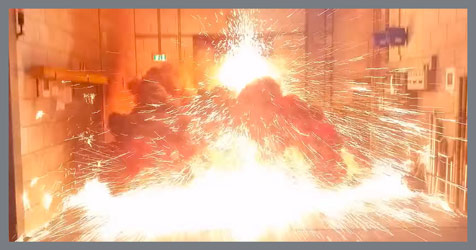
This test method aims to establish an APC1 or an APC2 rating of a fabric and/or garment (APC=Arc Protection Class). Test conditions for APC1 & APC2 try to simulate typical exposure conditions for a short circuit current of 4kA and 7kA respectively.
A single layer garment in most cases will pass APC1. For APC2, a thicker fabric or multi layer system is required.
This coverall is perfect for the demands of the offshore industry. Constructed with a highly innovative flame-retardant fabric with high visibility reflective tape double stitched for enhanced visibility. Meeting all the required EN standards, features include triple stitched seams, high visibility strips on shoulders, arms and legs, concealed 2-way front brass zip and two front slant chest pockets with concealed brass zips.
This coverall is perfect for the demands of the offshore industry. Constructed with a highly innovative flame-retardant fabric with high visibility reflective tape double stitched for enhanced visibility. Meeting all the required EN standards, features include triple stitched seams, high visibility strips on shoulders, arms and legs, concealed 2-way front brass zip and two front slant chest pockets with concealed brass zips.
This coverall is perfect for the demands of the offshore industry. Constructed with a highly innovative flame-retardant fabric with high visibility reflective tape double stitched for enhanced visibility. Meeting all the required EN standards, features include triple stitched seams, high visibility strips on shoulders, arms and legs, concealed 2-way front brass zip and two front slant chest pockets with concealed brass zips.
This coverall is perfect for the demands of the offshore industry. Constructed with a highly innovative flame-retardant fabric with high visibility reflective tape double stitched for enhanced visibility. Meeting all the required EN standards, features include triple stitched seams, high visibility strips on shoulders, arms and legs, concealed 2-way front brass zip and two front slant chest pockets with concealed brass zips.
This coverall is perfect for the demands of the offshore industry. Constructed with a highly innovative flame-retardant fabric with high visibility reflective tape double stitched for enhanced visibility. Meeting all the required EN standards, features include triple stitched seams, high visibility strips on shoulders, arms and legs, concealed 2-way front brass zip and two front slant chest pockets with concealed brass zips.
This coverall is perfect for the demands of the offshore industry. Constructed with a highly innovative flame-retardant fabric with high visibility reflective tape double stitched for enhanced visibility. Meeting all the required EN standards, features include triple stitched seams, high visibility strips on shoulders, arms and legs, concealed 2-way front brass zip and two front slant chest pockets with concealed brass zips.
This coverall is perfect for the demands of the offshore industry. Constructed with a highly innovative flame-retardant fabric with high visibility reflective tape double stitched for enhanced visibility. Meeting all the required EN standards, features include triple stitched seams, high visibility strips on shoulders, arms and legs, concealed 2-way front brass zip and two front slant chest pockets with concealed brass zips.
This coverall is perfect for the demands of the offshore industry. Constructed with a highly innovative flame-retardant fabric with high visibility reflective tape double stitched for enhanced visibility. Meeting all the required EN standards, features include triple stitched seams, high visibility strips on shoulders, arms and legs, concealed 2-way front brass zip and two front slant chest pockets with concealed brass zips.
This coverall is perfect for the demands of the offshore industry. Constructed with a highly innovative flame-retardant fabric with high visibility reflective tape double stitched for enhanced visibility. Meeting all the required EN standards, features include triple stitched seams, high visibility strips on shoulders, arms and legs, concealed 2-way front brass zip and two front slant chest pockets with concealed brass zips.
Specifications are subject to change - See Terms & Conditions for more info
Portwest has been independently rated by Ecovadis for its environmental, social, and ethical performance and achieved a silver rating, meaning they are in the top 25% of globally rated companies.
The pillars taken into consideration include the environment, labour practices and human rights, ethics, and sustainable procurement.
This product conforms with essential health and safety requirements as set out in European Directives.
This symbol indicates UKCA marking in progress at time of print. All products placed on the UK market from January 2023 must be UKCA marked.
This product is CE marked as a Category 3 item for complex design.
40+ UPF rated fabric to block 98% of UV rays.
This garment features 10 pockets.
This product has incorporated knee pad pockets that have been developed to carry Portwest's range of ergonomically designed knee pads.
This garment has a radio loop for easy attachment of a radio.
The smallest size this product goes down to is XS.
The largest size this product goes up to is 6XL.
Wash at a Maximum Temperature of 60°C using a normal wash cycle
Do not bleach this item
This item can be tumble dried on a normal temperature setting
This item can be ironed on a high temperature setting of up to 200°C
Do not dry clean this item
This item can only be washed a maximum of 50 times